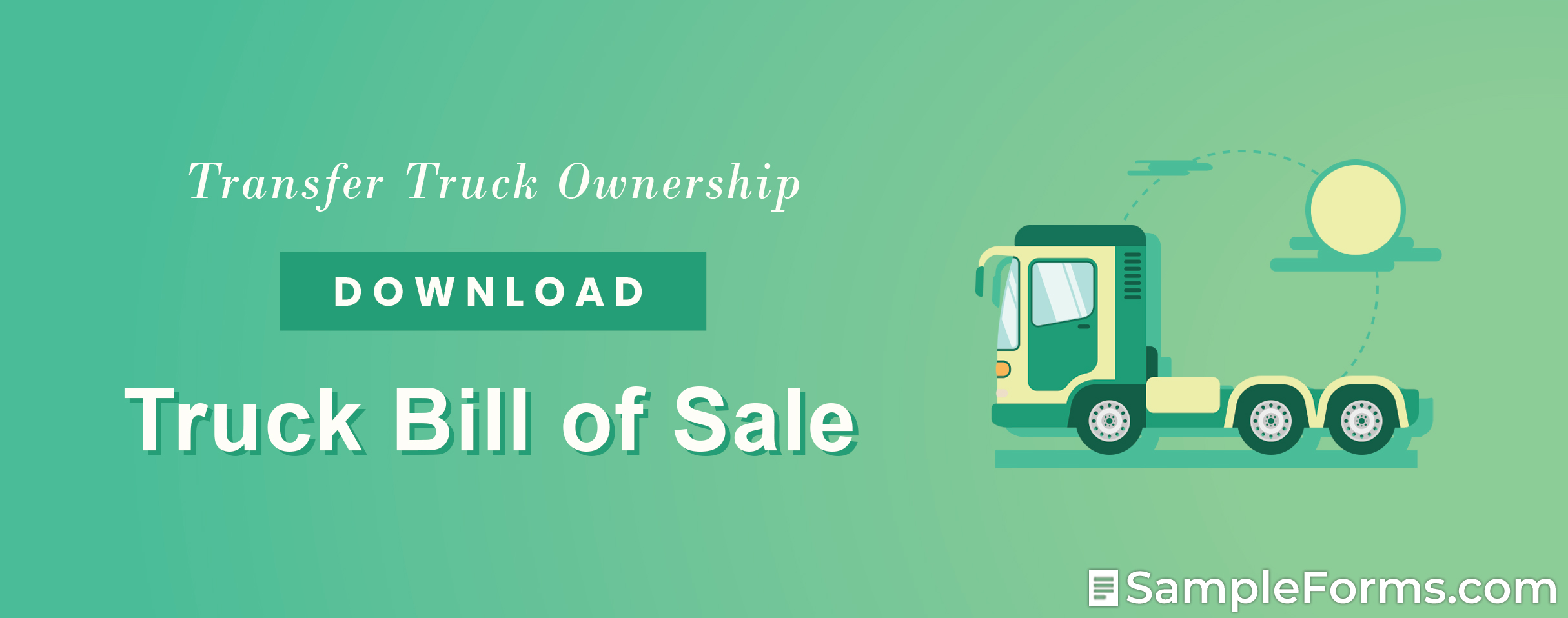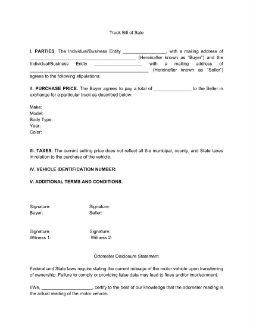- Eviction Notice Forms
- Power of Attorney Forms Forms
- Bill of Sale (Purchase Agreement) Forms
- Lease Agreement Forms
- Rental Application Forms
- Living Will Forms Forms
- Recommendation Letters Forms
- Resignation Letters Forms
- Release of Liability Agreement Forms
- Promissory Note Forms
- LLC Operating Agreement Forms
- Deed of Sale Forms
- Consent Form Forms
- Support Affidavit Forms
- Paternity Affidavit Forms
- Marital Affidavit Forms
- Financial Affidavit Forms
- Residential Affidavit Forms
- Affidavit of Identity Forms
- Affidavit of Title Forms
- Employment Affidavit Forms
- Affidavit of Loss Forms
- Gift Affidavit Forms
- Small Estate Affidavit Forms
- Service Affidavit Forms
- Heirship Affidavit Forms
- Survivorship Affidavit Forms
- Desistance Affidavit Forms
- Discrepancy Affidavit Forms
- Guardianship Affidavit Forms
- Undertaking Affidavit Forms
- General Affidavit Forms
- Affidavit of Death Forms
Truck Bill of Sale
One of the longstanding existing forms of trade is the exchange of goods and services through the trucking and logistics industry. And in a country as widespread as the United States, trucks and other large-scale vehicles is effective and cost-efficient means of transporting goods. More and more people and business entities are familiarizing and learning the documents needed for this sale, especially the truck’s bill of sale form. Read on to know more about the use and importance of these bill of sale forms. Read More
What Is a Truck Bill of Sale Form?

Similar to small-time vendors who take time to list down and record the details of a purchase, fillable bills of sale forms require identical information. Starting from knowing the details of the parties involved, identifying the specifications of the item, and down to the acknowledgment of both parties, a bill of sale form is evidence that proves a legal transaction. As a legal document bearing the signatures of both parties, it is an essential tool for both sides to defend themselves against fraudulent activities. In essence, a truck bill of sale form is a straightforward document that records the details of the sale, which both parties agree to.
How Do You Write a Truck Bill of Sale Form?
A bill of sale is an important document required for the vehicle’s registration process. It is an acceptable document that shows proof of purchase. Other than that, the motor vehicle bill of sale form is also necessary for processing the vehicle’s transfer of title. These various uses of a bill of sale form prove that writing one needs effort from both parties. Our site offers the basic steps and some tips on how to write and fill up an effective truck bill of sale form.
1. Know the Parties
Any legal agreement and contract start with the proper introduction of the parties involved. This part contains the formal names of those who are involved. This means that only you should cite the legal and registered names of the businesses. Moreover, aliases and other known-as names are not acceptable. Aside from these matters, mailing addresses are also essential. The last thing to note of when filling up this part is the label of who the buyer is and who the seller is. Assigning each party to either one concretizes the entire flow of the agreement.
2. Indicate Purchase Price
After introducing the parties, the next piece of information to introduce is the total purchasing price, which is the total amount of the truck. Also, do not forget to indicate if the reflected price already includes taxation. The price is one of the essential elements that make the bill of sale forms a legal proof of the transaction.
3. Specify the Item
Another element that makes the bill of sale proof of a legal transaction is the description of the item sold. For the truck bill of sale forms, it usually calls for the following details: manufacturer of the vehicle, model, body type, color, and year of manufacturing. Make sure to double-check the accuracy of these details. Another essential identifier of the car that needs to be included in the Vehicle Identification Number (VIN). The VIN is the 17-digit character sequence that reflects the vehicle’s unique features, specifications, and manufacturer.
4. Mind the Odometer Reading
The odometer reading and acknowledgment portion is a unique feature for the motor vehicle bill of sale forms. The odometer gauge or odograph shows the total distance that the vehicle has traveled. The accuracy of this detail is especially important for used vehicles because its use has a bearing on the total purchase price of the car. An odometer disclosure statement should be in the latter part of the form that states that the odometer reading is accurate.
5. State Additional Terms and Conditions
If either party has other concerns that were not covered above, you can add statements as additional terms and conditions that should be amenable for both parties. These additional terms often include arrangements regarding late payment, pending payment, or interest rates. Adding subsequent terms is vital in tailor-fitting the document for the particular transaction. Larger-scale purchases often call for more dynamic arrangements that need to be accounted for in any bill of sale form.
FAQs
Why is a bill of sale needed?
Bill of sale forms is especially important when purchasing all kinds of vehicles, including trucks. The form is a necessary document for the registration process, as with its re-registration. Aside from that, it is also needed when it comes to transferring the title of the vehicle. The Department of Motor Vehicles (DMV) also requires a bill of sale to keep an accurate record.
Can a bill of sale be voided?
Voiding the bill of sale—specific or general—is possible when the terms of the payment arrangement are not met. Normally, a bill of sale can be void when the buyer is unable to make the payment within three days after the sale. The grace period could be shorter or longer if the parties discussed it beforehand.
What happens when you sign a bill of sale?
Your signature on a bill of sale means that you agree to the purchase transaction and promise to follow the terms and conditions indicated in the document. You agree to follow through the purchase transaction, either as the buyer or seller.
Can a bill of the sale override a title?
A bill of sale cannot override a title because they serve different purposes. A bill of sale is a record of the transaction. Although it can reflect the transfer of ownership, it does not prove its legitimacy. Only a title is enough proof of ownership of a particular property or vehicle.
Is a purchase agreement the same with a bill of sale?
No, these two documents are different. The main difference lies in when these two documents are made. Purchase agreements are made and signed before the transaction. It contains the terms and conditions necessary to carry out the sale. On the other hand, you sign the bill of sale after the sale. In perspective, the bill of sale documents the transaction that was planned using a purchase agreement.

